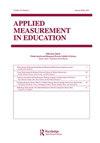模型拟合、不变性和有效性之间的权衡:以PISA科学评估为例
IF 1.1
4区 教育学
Q3 EDUCATION & EDUCATIONAL RESEARCH
引用次数: 15
摘要
摘要:在大规模的教育评估中,通常要求测试由在待比较的组中功能不变的项目组成。尽管努力确保项目构建阶段的不变性,但由于一系列原因(包括项目的安全性),通常有必要考虑项目的差异项目功能(DIF)。这通常需要在保留项目(尽管有DIF)、删除项目或通过为每个组创建一个不同的项目来解决(拆分)项目之间进行选择。这些选项涉及模型拟合和项目参数不变性之间的权衡,每个选项都可能有效,这取决于DIF的来源是否与被评估的变量相关或无关。我们认为,做出选择需要仔细分析统计DIF及其实质性来源。我们通过使用Rasch模型分析三个国家(英国、法国和约旦)的PISA 2006科学数据来说明我们的论点,Rasch模型是用于分析PISA 2006所有数据的模型。我们确定了各国具有真实DIF的项目,并检查了当这些项目被消除、解决或保留时,对模型拟合、不变性和跨国比较的有效性的影响。本文章由计算机程序翻译,如有差异,请以英文原文为准。
The Trade-Off between Model Fit, Invariance, and Validity: The Case of PISA Science Assessments
ABSTRACT In large-scale educational assessments, it is generally required that tests are composed of items that function invariantly across the groups to be compared. Despite efforts to ensure invariance in the item construction phase, for a range of reasons (including the security of items) it is often necessary to account for differential item functioning (DIF) of items post hoc. This typically requires a choice among retaining an item as it is despite its DIF, deleting the item, or resolving (splitting) an item by creating a distinct item for each group. These options involve a trade-off between model fit and the invariance of item parameters, and each option could be valid depending on whether or not the source of DIF is relevant or irrelevant to the variable being assessed. We argue that making a choice requires a careful analysis of statistical DIF and its substantive source. We illustrate our argument by analyzing PISA 2006 science data of three countries (UK, France and Jordan) using the Rasch model, which was the model used for the analyses of all PISA 2006 data. We identify items with real DIF across countries and examine the implications for model fit, invariance, and the validity of cross-country comparisons when these items are either eliminated, resolved or retained.
求助全文
通过发布文献求助,成功后即可免费获取论文全文。
去求助
来源期刊

Applied Measurement in Education
Multiple-
CiteScore
2.50
自引率
13.30%
发文量
14
期刊介绍:
Because interaction between the domains of research and application is critical to the evaluation and improvement of new educational measurement practices, Applied Measurement in Education" prime objective is to improve communication between academicians and practitioners. To help bridge the gap between theory and practice, articles in this journal describe original research studies, innovative strategies for solving educational measurement problems, and integrative reviews of current approaches to contemporary measurement issues. Peer Review Policy: All review papers in this journal have undergone editorial screening and peer review.
 求助内容:
求助内容: 应助结果提醒方式:
应助结果提醒方式:


